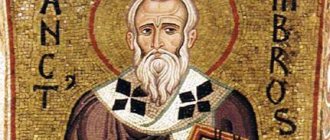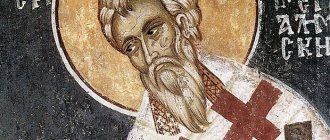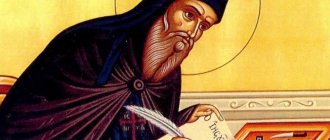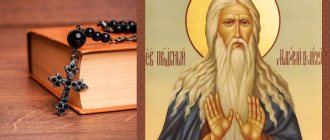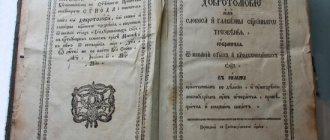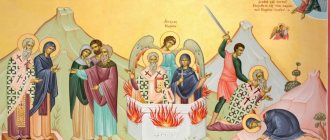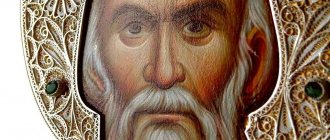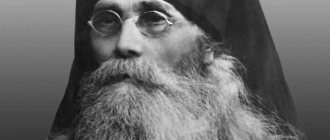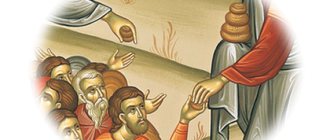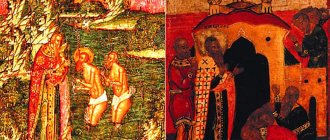| Sschmch. Cyprian of Carthage |
Cyprian of Carthage
(c. 200 - 258), bishop, martyr. Memory 31 August [1].
Born around 200 in the city of Carthage (North Africa). Fascius Cyprian was the son of a wealthy pagan senator, received an excellent secular education and became a brilliant orator, teacher of eloquence and philosophy at the Carthaginian school. He often appeared in courts as an intercessor and defender in the cases of his fellow citizens. Cyprian later recalled that for a long time he “remained in the deep darkness of the night..., far from the light of Truth.” The famous rhetorician spent the fortune inherited from his parents and acquired through his activities on luxurious feasts, but they could not drown out his thirst for truth. Having become interested in Christianity, he became acquainted with the writings of the apologist Presbyter Tertullian. Subsequently, the saint wrote that it seemed impossible to him then, given his skills, to achieve the rebirth promised by the Savior.
His friend and leader, Presbyter Kekiliy [2], brought him out of such a difficult and indecisive state. At the age of 46, the most learned pagan was accepted into the Christian community as a catechumen. Even before receiving baptism, he distributed all his property to the poor and moved to the house of Saint Kekilia.
Saint Cyprian wrote in a letter to his friend Donatus about his baptism:
“When the regenerating wave cleansed the impurities of my former life, a light, quiet and clear, descended from Heaven into my heart.
When the second birth by the Heavenly Spirit changed me into a new person, I was miraculously strengthened against doubts, secrets were revealed, darkness was illuminated... I learned that what lived in me according to the flesh for sin belonged to the earth, but now God began, living by the Holy Spirit. All our strength is in God and from God; from Him is our strength. Through Him, living on earth, we have a premonition of a future blissful state.” About a year after his baptism, the saint was ordained a presbyter, and when the Carthaginian Bishop Donatus died, at the request of the entire Carthaginian Church, which did not want to see anyone as its bishop except Cyprian (aut Cyprianus, aut NULLus), contrary to canonical rules, he was appointed bishop of Carthage (about 248).
The saint first of all took up the improvement of the church and the eradication of vices among the clergy and flock. The holy life of the archpastor made everyone want to imitate his piety, mercy and wisdom. The fruitful activity of Saint Cyprian became known beyond the borders of his diocese. Bishops of other departments often turned to him for advice on what to do in this or that case. The persecution of Emperor Decius (249-251), about which the saint was revealed in a dream vision, forced him to hide. His life was needed by the flock to strengthen faith and courage among the persecuted. Before leaving the diocese, the saint divided church property among all the clergy to help those in need and subsequently sent additional funds.
He kept in constant contact with Carthaginian Christians through his envoys, writing letters to elders, confessors and martyrs. Some Christians, fearing torture, made sacrifices to the pagan gods. These fallen Christians turned to confessors, asking them to give them so-called letters of peace
, i.e. petition notes for their acceptance into the Church. Saint Cyprian wrote a message to the entire Carthage Christian community, in which he indicated that those who had fallen away during persecution could be accepted into the Church, but this must be preceded by consideration of the circumstances under which the falling away took place. The sincerity of the contrition of the fallen must be verified. They can be accepted only after church repentance and with the permission of the bishop. Some of the fallen insistently demanded their immediate admission into the Church and thereby embarrassed the entire community. Saint Cyprian wrote to the bishops of other dioceses, asking their opinions, and from all he received full approval of his orders.
During his absence, the saint authorized four clergy to check the lives of people who were preparing to be ordained presbyters and deacons. This met with resistance from the layman Felikissimus and the presbyter Novatus, who rebelled against their bishop. Saint Cyprian excommunicated Felixsimus and six of his supporters. In his letter to his flock, the saint touchingly exhorted everyone not to separate from the unity of the Church, to obey the lawful orders of the bishop and wait for his return. This letter kept the majority of Carthaginian Christians faithful to the Church.
Soon Saint Cyprian returned to his flock. Felixsimo's indignation was put to an end at the Local Council of 251. The same Council passed judgment on the possibility of accepting the fallen into the Church after they had brought church repentance and confirmed the excommunication of Felixsimo.
At that time, a new schism was brewing, raised by the Roman presbyter Novatian, who was joined by the Carthaginian presbyter Novatus, a former supporter of Felicissimus. Novatian argued that those who fell away during persecution could not be accepted back, even if they repented of their sin. In addition, Novatian, with the help of Novatus, convinced three Italian bishops during the lifetime of the legitimate Roman Bishop Cornelius to appoint another bishop, Novatian, to the Roman See. Against such lawlessness, Saint Cyprian wrote a series of district letters to African bishops, and then an entire book “On the Unity of the Church.”
When discord began to subside in the Carthaginian Church, a new disaster began - a pestilence broke out. Hundreds of people fled the city, leaving the sick without help and the dead without burial. Saint Cyprian, showing an example of steadfastness and courage, himself cared for the sick and buried the dead, not only Christians, but also pagans. The pestilence was accompanied by drought and famine. Hordes of barbarian Numidians, taking advantage of the disaster, attacked the inhabitants and took them captive. Saint Cyprian encouraged many wealthy Carthaginians to donate their funds to feed the hungry and ransom prisoners.
When a new persecution of Christians began by the emperor Valerian (253-259), the Carthaginian proconsul Paternus ordered the saint to sacrifice to idols. He firmly refused to do this, and also to reveal the names and location of the elders of the Carthaginian Church. The saint was exiled to the area of Kurubis. Deacon Pontius followed his bishop into exile voluntarily. On the day when the saint arrived at the place of exile, he saw a dream that foreshadowed his imminent martyrdom. While in exile, Saint Cyprian wrote many letters and books. Wanting to suffer in Carthage, he himself returned there. Brought to trial, he was left free until the following year. Almost all Carthaginian Christians came to say goodbye to their bishop and receive his blessing. At his trial, Saint Cyprian calmly and firmly refused to sacrifice to idols and was sentenced to beheading by the sword. Hearing the verdict, Saint Cyprian said: “Thanks be to God!” and all the people exclaimed in one voice: “And we want to die with him!” Arriving at the place of execution, the saint again gave a blessing to everyone and ordered that 25 gold coins be given from him to the executioner. Then he blindfolded himself, gave his hands to the presbyter and subdeacon standing near him, and bowed his head. Christians, weeping, spread scarves and head coverings in front of him to collect the sacred blood. Martyrdom followed on September 14, 258. The saint's body was taken at night and buried in the private cemetery of the procurator Macrovius Candidian.
Subsequently, under King Charlemagne (771-814), his holy relics were transferred to France.
Brief biography of the saint
The Bishop of Carthage is one of the most significant figures and educators of the early Christian church, revered equally by Catholics, Orthodox and Protestants.
Origin
Cyprian was born in the capital of the North African Roman province - Carthage. The approximate date is 200/210. His father was a rich and noble Roman senator, a follower of the ancient pagan gods.
Life
The young man had great abilities:
- analytical mind;
- excellent memory;
- developed speech.
At the Carthaginian school the saint acquired knowledge of philosophy and rhetoric. Cyprian was a brilliant orator, with expressive, reasoned speech. For a long time he taught rhetoric and acted as a defense attorney in court proceedings. The successful lawyer became interested in Christian doctrine when he was 40 years old.
Cyprian, accustomed to logical formulations and constructions, found it difficult to understand the Christian doctrine. He was greatly influenced by the works of Tertullian, one of the first early Christian theologians.
Tertullian, like Cyprian, was born in Carthage, in the family of a centurion (commander of a large military unit). He studied rhetoric and philosophy in Rome, then returned to Carthage, where he converted to Christianity and was ordained a presbyter in the year 200.
The founder of theology in his writings rejected the possibility of a logical understanding of biblical texts, believing that it should be interpreted literally. Tertullian's thesis that pure faith in God cannot have a logical basis became fundamental in Christianity.
Thanks to communication with the presbyter Kekilius, Cyprian was finally established in the Christian faith, and at the age of 46 he received the status of a catechumen, and then was baptized. The introduction to Christianity, according to the saint, illuminated life and calmed spiritual passions. Following Christian morality, he distributed property to the poor, left a rich house and settled with Kekilia. A year after his baptism, the saint was ordained a presbyter. And then he was confirmed as bishop of the Carthage Church.
The change in power of the Roman emperors was reflected in the attitude towards Christians. In 250, the first wave of persecution and an attempt to restore the pagan faith began. Cyprian foresaw the persecution and left Carthage, having first distributed church property among the remaining clergy.
After the death of the emperor, the shepherd returned to Carthage, where opposition formed against him. The reason was a disagreement regarding the apostates who wanted to return to the fold of the Church after the end of the persecution.
With the coming to power of Emperor Valerian, the persecution of Christians was repeated. After the saint refused to make a sacrifice in a pagan temple, he was sent into exile to Kurbus (150 kilometers from Carthage), where he stayed for a year. Here in a dream it was revealed to him that martyrdom would soon await him.
A year later, the shepherd was returned to Carthage, where he was again forced to return to the pagan faith.
Serving God
The saint was actively involved in church affairs, setting an example of humility, piety and godly wisdom. Saint Cyprian was a born spiritual shepherd. Hiding from persecution under Emperor Decius, he did not interrupt communication with the community, exchanging letters with them.
Out of fear of the death penalty, part of the higher clergy renounced Christian doctrine and made sacrifices to pagan idols. After the death of the emperor, the bishops wished to become Christians again through repentance before the confessors (believers who had not renounced Christ).
The saint made an appeal, supported by the majority of bishops at the Council of 251, in which he indicated that refuseniks could be accepted back only after church repentance and the permission of the bishop.
In addition, in Rome, with the support of the Carthaginian clergy, an attempt was made to remove the current bishop. These circumstances prompted the saint to write a dogmatic work “On the Unity of the Church.” During his second exile under Emperor Valerius, Saint Cyprian devoted himself to writing theological works and letters.
Demise
At the second trial, Cyprian again refused to bow to the pagan gods and was sentenced to death. The saint bravely faced his last hour. He blindfolded himself with the words: “Thanks be to God.” On September 14, 258, he was beheaded. That night his body was buried in a private cemetery. After 5 centuries, the holy relics were transferred to France.
What do people pray to Cyprian of Carthage for?
The life of Cyprian of Carthage is filled with piety, humility and unshakable faith. You need to read the Cyprian prayer every day without any abbreviations until your spiritual or physical condition (health) improves. You can read for yourself and for your loved ones (for children).
Prayers to Cyprian of Carthage are aimed at protecting:
- from damage
- from the evil eye
- from the devil's tricks
- from enemies
- from the influence of dark forces
- from anger and envy
- from demons.
The creative heritage of the saint
Saint Cyprian is the author of the doctrine of the unity of the Church, 12 treatises and 65 letters.
Essays
The extensive theological heritage is explained by the practical activities of Bishop Cyprian. By nature he was a spiritual shepherd, not a theologian. For centuries, the epistolary works of the saint were considered role models in the content and form of presentation of Christian teaching.
Treatises
12 treatises have survived that had a significant influence on clergy and believers. Particularly noteworthy is the treatise “On Mortality” regarding the plague, when the sick were abandoned without care. Exhortations and arguments had an effect on people who remembered showing mercy to their neighbors.
Letters
65 letters written by Cyprian's hand have survived. Of these, 40 were written during exile, including more than half addressed to the clergy and flock of the Carthaginian church. 25 letters were written regarding the return of refuseniks to the fold of the Church. The saint's letters reflect current church problems, which is valuable historical material.
Teaching
Saint Cypirian wondered what the unity of the Church was. He based his teaching on the Dogmas of the Old and New Testaments. At an early stage (before the 3rd century), the unity of the Church of Christ was determined by two criteria: the presence of a community of co-religionists and a bishop elected from among them, observing and organizing religious ceremonies.
The sanctity of the elected religious leader was confirmed by the ordination of bishops from other communities. Thus, the internal unity of territorially separated communities was preserved.
The Holy Spirit was considered the main unifying force of Christians, under whose influence a spirit of fraternal mutual assistance and love was formed in communities. At the same time, there must be a sincere desire on the part of believers to follow these rules.
It was impossible to visually determine the boundaries of the Church, since the communities were located at considerable distances from each other. There was no single center to which all believers would submit. Different theologians have developed their own theories of understanding the Holy Scriptures. Disputes about the essence of dogmas were resolved at Ecumenical Councils. Fierce disagreements at the beginning of the 4th century caused a split in church life.
Saint Cyprian created the doctrine of the unity of the Church, calling the main consolidating force of the bishop appointed by God. The first bishop appointed by Jesus Christ was the Apostle Peter. This became the dogmatic basis of the doctrine of the One Church. Subsequent bishops were his successors, and the Grace of God passed to them. The bishops, to whom the power and authority of the Apostle Peter passed, obeyed only God.
Only one bishop could occupy the Throne. The essence of the teaching is that those who do not obey the bishop are considered heretics and sinners. The Roman Catholic and Anglican Church is built on this principle. Some of the provisions are used in church practice by the Orthodox Church.
The institution of episcopate (hierarchical structure), according to Saint Cyprian, is called upon to preserve the unity of the true Church. He is the barrier separating the true, universal Church from imaginary imitators.
Truth was determined by several criteria:
- true doctrine;
- keeping the commandments of the New Testament;
- constant communication between church communities.
Saint Cyprian was a supporter of logic, discipline and order, which was reflected in his teaching. Following his conclusion, the One True Church unites the elected under the leadership of bishops. Only these believers have the right to receive the gifts of the Holy Spirit and eternal life in the Kingdom of Heaven. The bishop has the right to excommunicate for sins.
CYPRIAN
The most ancient monuments of the veneration of K. are hagiographic works. The last year of K.’s life and execution are reported in the Acts, or Martyrdom, of the saint (BHL, N 2037-2040; CPL, N 53). Since the text includes fragments of the interrogation protocols of K., which were carried out by the proconsuls of Africa, this work is often called Proconsular Acts (lat. Acta proconsularia). According to most researchers, the Acts were created shortly after the martyrdom of K. and are a valuable historical source. Thanks to the research of R. Reitzenstein, it turned out that the text of the Acts was preserved in numerous versions, which can be combined into 2 editions (the researcher published 7 versions: Reitzenstein. 1913; Idem. 1919). In the manuscripts, the 1st edition is contained together with the works of K., the 2nd edition is included in the Middle Ages. legendaries on September 14 (for a description of the manuscripts see: Lanata. 1973. P. 242-244; Acta Cypriani. 1987. P. 197-202). The editions vary in composition. The 1st edition reports only on the events of 258, i.e., on K.’s return from exile, on the death sentence passed on him by proconsul Galerius Maximus, and on the execution of the saint (September 14, 258). The 2nd edition also tells about the 1st trial of K., at which the proconsul Aspasius Paternus sentenced the saint to exile (Aug. 30, 257), and about the re-arrest of K. on the orders of Galerius Maximus. According to A. A. R. Bastiansen, the 1st edition, compiled shortly after K.’s execution, was addressed to the Christians of Carthage. Later, for believers who lived in other places and wanted to learn more about the saint’s feat, the 2nd edition was written. It was this text that received the greatest distribution; it was used in the works of the Diak. Pontius, Prudentius and Blessed. Augustine (Acta Cypriani. 1987. P. 202-204).
Despite the use of documentary sources (interrogation protocols), Acts of K. - lit. work created by Christ. by the authors (Lanata. 1973. P. 188-193). They make an attempt to portray the saint not only as the head of Christ. communities of Carthage, but also as an influential Rome. a tycoon surrounded by followers and servants (see: Hunink. 2010). The saint behaved with restraint and dignity; he politely but firmly responded to the proconsul’s demands to renounce Christ and hand over his clergy. In the last hours of his life, K. did not forget about his neighbors. On the night before the court hearing, a crowd of Christians gathered at the house where the bishop was kept, and the saint gave orders to protect the girls who came. Before the execution, K. ordered the executioner to be paid 25 gold coins. The Acts emphasize that the saint enjoyed the respect of pagans and the boundless devotion of Christians. The authorities treated the bishop with respect: officials from the proconsul's retinue were sent to arrest K., and he spent the night in the house of one of them. Attention is paid to K.'s gestures: for example, it is described how he took off his outer clothing and prepared for execution with the help of clergy. In conclusion, K.’s night burial is reported, which is presented as a solemn procession with candles and torches.
No later than the beginning IV century in Donatist circles, a special version of the Acts of K. was created, to which minor changes were made (Maier. 1987-1989. T. 1. P. 122-126; Donatist Martyr Stories: The Church in Conflict in Roman North Africa / Transl. , not., introd. M. A. Tilley. Liverpool, 1996. P. 1-5; see: García. 1976. P. 47-49). In the Middle Ages, the Acts were distributed in different versions: for example, the Franco-Spanish one was included in the so-called. Spanish Passionary (Pasionario Hispánico / Ed. A. Fábrega Grau. Madrid, 1955. T. 2. P. 336-338).
The Life of Cyprian (BHL, N 2041; CPL, N 52) is preserved in manuscripts as an anonymous work. According to the testimony of the blessed Jerome, the author was a deacon. Pontius, who accompanied K. into exile (Hieron. De vir. illustr. 68). The significance of the “Life of Cyprian” in the history of hagiographic literature has become a subject of controversy among researchers. A. von Harnack, who carried out the critical edition of the text, considered it “the first Christian biography.” In his opinion, the Life of Cyprian reflected the earliest attempt of Christ. hagiographers describe not only the suffering and death of the martyr, but also his life. Nevertheless, almost half of the work is devoted to K.’s exile and execution (Harnack. 1913. S. 36-42). Dr. researchers considered the “Life of Cyprian” to be Christian. a version of the legend about the “death of a great man” (exitus illustrium virorum - Reitzenstein. 1913. S. 52-53) or a panegyric speech with elements of apology (Corssen. 1917. S. 206-207; see: Barnes. 2010. P. 82-85). A negative attitude towards Harnack's hypothesis was expressed by I. Delehaye (Delehaye. 1966). Modern researchers are inclined to believe that “The Life of Cyprian” is a single work that did not have a significant influence on Christ. literature, other similar works were compiled much later (for example, the Lives of St. Pachomius the Great and St. Anthony the Great). A description of K.'s life path was given by diak. Pontius for apologetic purposes (Ziegler. 2009). Reitzenstein and Delee rated the Life of Cyprian low both as a lit. work, and as a historical source. According to researchers, the compiler abused school rhetoric to the detriment of the content; the information he provided does not always agree with the data of the Acts (see: Delehaye. 1966. P. 75-77).
Diak. Pontius considered it his task to save the good deeds (opera) and merits (merita) of K. from oblivion for the sake of edifying Christians, glorifying the saint and protecting him from accusations. The image of K. is close to that described in the Acts: the saint is presented as a noble Roman who shared traditions. values of the Roman elite. society. He was educated and eloquent, distinguished by temperance (continentia) and generosity (clementia), strictly fulfilling moral obligations (pietas), was courageous and had a sense of self-esteem. Thanks to his ability to deal with people, K. enjoyed universal respect. Speaking of K., Diak. Pontius especially often used concepts such as “glory” (gloria) and “honor, dignity” (honor; see: Harnack. 1913. S. 70-71). When the persecution of Christians began, high-ranking acquaintances persuaded K. to hide, but he, despising death, rejected their offers. The execution of the saint, which took place in the presence of many people, is presented as a triumph (illius victoria triumphanda est - Pontius. Vita. 19. 3). Diak. Pontius emphasized that K. became the first bishop in Africa to suffer martyrdom (sacerdotales coronas in Africa primus imbueret - Ibid. 19.1).
In much more detail than in the Acts, the Life of Cyprian reports on the pastoral activity of the bishop, “the pious primate and glorious witness of God” (religiosus antistes ac testis Dei gloriosus - Ibid. 1. 1), who completed his ministry by becoming “a pleasant sacrifice to God” (placentem Deo hostiam - Ibid. 15.1). Diak. Pontius not only wrote that K. cared about his flock, the weak and the disadvantaged, but also noted his learning, eloquence, and the presence of great literature. heritage (unpreserved sermons of the saint are quoted).
According to some researchers, the main task of the compiler was to protect K. from the accusations made by his opponents (Ziegler. 2009; Barnes. 2010. P. 82-85). The most serious was the accusation that under the imp. Decius, when the persecution of Christians began, K. abandoned his flock and disappeared (cf.: Cypr. Carth. Ep. 8). Apparently, there were other questions, for example. about the house that K. sold after converting to Christ and subsequently. was again in his possession. The explanation of K.'s actions caused the deacon. Pontius's difficulties. According to the biographer, although K. was honored to be included in the “proscription lists” (proscriptionis gloria - Pontius. Vita. 7.1), he chose to hide and thereby protect his flock from the rage of the pagans. The significance of K.’s personality and activity was so great that God Himself wished to leave the saint alive, and he humbly submitted to God’s will. Afterwards K. received a revelation of his impending death, and he courageously suffered for Christ.
The influence of ancient literature on the Life of Cyprian was manifested in the widespread use of oratory techniques, for example. periods with homoyothelevton, antithesis, questioning, deliberately pompous expressions (amplificatio), refutations of unspoken objections (refutatio), as well as comparisons (comparatio): K. is likened to the converted ap. Philip to the eunuch (Acts 8.27-39), the courageous Tobias (Tob 1.16-19), Job, while it is emphasized that the saint surpassed them all, he had no equal since the time of the apostles (Pontius. Vita. 19.1) (Harnack. 1913. S. 45-50; Delehaye. 1966. P. 72; Montgomery. 1996. P. 205-210). From hagiographic works on diac. Pontius was influenced by the Martyrdom of Perpetua and Felicity (Reitzenstein. 1913. S. 49-50; Martin. 1919; Aronen. 1984), including in the description of the mysterious vision of K., which plays an important role in the narrative (Pontius. Vita 12. 3-9). The Life of Cyprian was among the examples of later African monuments. hagiography - Martyrdom of Lucius and Montana (CPL, N 2051), "Life of Augustine" by Possidio, Donatist works - Martyrdom of Marculus (CPL, N 720) and Martyrdom of Maximian and Isaac (CPL, N 721) (eg: Corssen. 1916. S 189).
K. is mentioned in writings about Africa. martyrs who suffered during the persecution under the Emperor. Valerians. The Martyrdom of Marian and James (CPL, N 2050) tells of a vision that was sent down to console Christians imprisoned: Marian saw K., who had drunk the cup of suffering and was seated at the right hand of the Heavenly Judge (Franchi de'Cavalieri P. La Passio SS. Mariani et Iacobi. R., 1900. P. 53-55. (ST; 3)). In the vision of the martyr. Montana, who was also awaiting execution, the centurions brought the martyr to the endless plain, where K. and Leucius (probably the bishop who suffered martyrdom) appeared before him. The compiler of the Martyrdom of Lucius and Montana also recounts the story of Flavian, who was sentenced to death, about a vision he had: at the beginning of the persecution, “when only our bishop [Cyprian] suffered,” Flavian asked the saint how painful a blow from a sword could be and how one could endure this pain . The executed bishop replied that the body does not feel pain if all thoughts are turned to God (Dolbeau F. La Passion des saints Lucius et Montanus: Histoire et édition du texte // REAug. 1983. Vol. 29. P. 73-74, 80 ). These visions were supposed to strengthen Christians and prepare them for the feat “in accordance with the faith and piety that they learned from Cyprian” (Ibid. P. 75).
A special version of the hagiographic legend about K. is presented in the poem of Prudentius, written between 398 and 404. (Prudent. Perist. 13). In the introduction, Prudentius contrasts African. K.'s identity to his worldwide fame and influence. Holy family in Africa, where he suffered martyrdom and was buried, but his creations became the property of all Christ. peace. In his youth, K. practiced witchcraft, but the grace sent by Christ led him to true faith. Thanks to zeal in ascetic deeds and in the comprehension of Christ. His teachings were considered worthy to occupy the episcopal see. The wicked persecutors Valerian and Gallienus proclaimed a death sentence for all Christians, but K. convinced the flock not to yield to their threats and firmly confess Christ. The saint was imprisoned in a deep prison, where he prayed for strength and courage to be sent to Christians, whom the persecutors subjected to terrible torture. God heard K.'s prayer: African. Christians remained firm in the faith and suffered martyrdom (the legend of the martyrs of Massa Candida is retold here, see Art. Square). The enraged proconsul immediately sentenced K. to death. In conclusion, Prudentius emphasizes that K. became a martyr and ascended to heaven, but, as a mentor and teacher of the Church, he continues to live in his lit. works.
From the 4th century K. was often regarded as the greatest saint of Africa. Blzh. Augustine called K. “the leader of the Africans” (Afrorum rector - Aug. Serm. 313G). In response to the insults of Julian of Eclan, who called his opponents “African bandits” and “Punic squabblers,” he proudly pointed out that K. was also an African (Aug. Contr. Julian. III 17 // PL. 44. Col. 718- 719). Sulpicius Severus in his “Dialogues” called for telling the world about the miracles of St. Martin: “Let Carthage learn more about him... and let [the city] admire not only its martyr Cyprian, although he is sanctified by the blood of this saint” (Sulp. Sev. Dial. II (III) 17). Diak. Pontius wrote about Carthagini as the “true” founder of the episcopal see of Carthage, but no information has been preserved about the origin of the throne (ex quo enim Carthagini episcopatus ordo numeratur - Pontius. Vita. 19. 1). Afterwards St. Optat, ep. Milevsky, called Carthage “the See of Cyprian” by analogy with the Papal Throne, “the Chair of St. Peter" (Optat. Contr. Parmen. I 10). St. Gregory I the Great in a letter to the Bishop of Carthage. Dominic (Oct. 595) promised to pray for him in front of the tomb of St. Peter and asked to pray for himself in front of K.’s tomb (Greg. Magn. Reg. epist. VI 19).
K. enjoyed special veneration among supporters of Donatism, who considered themselves faithful followers of the saint. Pointing to K.'s non-recognition of the sacraments of heretics and schismatics, to his martyrdom, the Donatists substantiated with K.'s authority the legitimacy of the severance of communication with the Orthodox Church. Church (eg: Aug. De bapt. contr. donat. I 1, 18; II 1, 3). The Donatists compiled a collection of K.'s messages, at the beginning of which the Acts of the saint are placed (Mengis K. Ein donatistisches Corpus cyprianischer Briefe. Freiburg i. Br., 1916). Presumably at the beginning. V century a forged message from K. was created to the Carthaginian people. The message is directed against “traitors” (traditores - clergy who gave the books of the Holy Scriptures to the pagan authorities during the era of the so-called great persecution), by which the Donatist compiler meant the Orthodox clergy (CPL, N 722; Maier. 1987-1989. T. 2. P. 194-198).
In polemics with the Donatists, and later. and with the Pelagians the blzh relied on K.’s authority. Augustine: in his works the name of the saint is mentioned 589 times (Yates. 2005. P. 122). Challenging the claims of the Donatists to the spiritual heritage of K., Blessed. Augustine was forced to admit that they actually relied on certain provisions of his doctrine, which were developed in Donatist ecclesiology. According to blzh. Augustine, K.’s teaching on the boundaries of the Church was erroneous: “I do not accept what Blessed Cyprian thought about the baptism of heretics and schismatics, because the Church does not accept this” (Aug. Contr. Cresc. II 40). Blzh. Augustine emphasized the difference between the works of K., which could contain inaccurate and erroneous statements, and St. Scripture, which had unconditional authority (litteras Cypriani non ut canonicas habeo, sed eas ex canonicis considero - Ibidem). The Donatists were stubborn schismatics and attached undue importance to certain aspects of the doctrine of Q.; in contrast to them, K. considered it most important to preserve the unity of the Church and peace between the Orthodox (García. 1976. P. 14-33). Objecting to the Donatists, who pointed to K. as the founder of their community (auctor vestrae divisionis), Bl. Augustine called the saint “the great defender of Catholic unity and peace” (Aug. Contr. Cresc. II 39). K.'s misconceptions were leveled by the feat of martyrdom, since he suffered for the sake of preserving the unity of the Church (see: García. 1976. P. 7-14). Earlier, similar thoughts were expressed by Optatus Milevsky, who called K. a peacemaker bishop (pacificus episcopus - Optat. Contr. Parmen. I 19).
After the successful completion of the polemic with the Donatists, Bl. Augustine was able to rely with greater confidence on the works of K., which he proclaimed as the standard of Orthodoxy. teachings (Yates. 2005). In disputes with the Pelagians, he placed extremely high importance on the authority of K., “the most famous teacher and the most glorious witness” (doctor praeclarissime et testis gloriosissime - PL. 44. Col. 691). To contradict K. meant to reject the teaching of the apostles and the Universal Church (Aug. Contr. secund. Julian. I 106 // PL. 45. Col. 1120-1121). Evidence that God approved the teachings of K. was the martyrdom of the saint for the sake of the prosperity of the Church: “Look, I used the words of the Punic bishop Cyprian, the martyr against whom you lie, taking up arms against the strongest faith of the very Church for which he shed his blood” ( Ibidem).
In polemics with the Pelagians, Bl. Augustine acted as a continuator of the work of K., who fought against false teachings and defended the unity of the Church. He emphasized that K.’s teaching is completely in accordance with the Holy Spirit. Scripture, while the Pelagian heresy is an innovation alien to the Church. In op. “On the Acts of Pelagius” Bl. Augustine recalled how he preached a sermon against the Pelagians in Carthage, holding the letter of K. (Cypr. Carth. Ep. 64; implied sermon on infant baptism - Aug. Serm. 294 // PL. 38. Col. 1335-1348 ; see: Idem. De gest. Pelag. XI 25; Yates. 2005. P. 125). According to Augustine, K. exposed Pelagianism long before its appearance, the works of the saint became an “antidote” to heresy (ante quot annos, contra ea quae futura erant Pelagianorum venena, quale sit antidotum praeparatum - Aug. De dono persev. I 2. 4 / / PL. 45. Col. 996; compare: Idem. Contr. Julian. II 3. 6 // PL. 44. Col. 676-677). K. taught about original sin, the impossibility of salvation without grace and the need for infant baptism (Idem. Contr. Pelag. IV 8.21-11.29). According to Augustine, in op. “On the Lord's Prayer” K. argued that grace is an undeserved gift of God, only with its help a person suffering from the consequences of original sin is able to be reborn to eternal life (Idem. De dono persev. I 2.4 // PL. 45. Col. 996-997). K. felt the sinfulness of human nature from his own experience, but with the help of the given grace he was able to overcome temptations and receive a victorious crown (Idem. Contr. Julian. II 8. 25 // PL. 44. Col. 690-691). Thanks to K.’s testimony, “we can prove that we are defending the Catholic faith from the novelty of your false and impious errors,” wrote Augustine to Julian of Eclan (Ibid. III 17. 32-33 // Ibid. Col. 718-719).
There are 12 known sermons of the blessed one. Augustine, dedicated to K., which were pronounced on the saint’s memorial day (taking into account the fragmentary homily discovered in 2007 in Erfurt - Aug. Serm. 313G). The topics of the sermons were varied; the preacher took into account that the basic information about K. was well known to the audience. In addition, on the day of the holiday they could pronounce several. sermons (Hunink. 2011). Blzh. Augustine recounted the Acts of K., dwelling in detail on the saint’s conversion to Christ (Aug. Serm. 309) or his martyrdom (Aug. Serm. 312), and explained the meaning of the readings and psalms of the holiday.
In Carthage, at the site of K.’s execution and burial, there were temples, which are repeatedly mentioned in sources of the 4th-6th centuries. According to the Acts, K. was buried in the suburbs of Carthage, on the Mappalian road near the cisterns, on the land plot of the procurator Macrobius Candidate (or Candidian) (in areas Macrobi Candidati procuratoris, quae sunt in via Mappaliensi iuxta piscinas - Acta Cypriani. 1987. P. 230 ). In the Martyrdom of Maximilian, who suffered in 295, it is reported that the body of the saint was brought to Carthage and buried “next to the martyr Cyprian, under a hill, not far from the palace” (CPL, N 2052; The Acts of the Christian Martyrs / Ed. H. Musurillo. Oxf., 1972. P. 248). According to Sulpicius Severus, the tomb of K. was considered the most important shrine of Carthage, it was visited by pilgrims who arrived from afar (Sulp. Sev. Dial. I 3). In the tale of the miracles of St. Stephen mentions how Rustica, a noble resident of Carthage, in fulfillment of her vow, went to the Easter service in the Mappalian Basilica of Carthage (CPL, N 391; PL. 41. Col. 848).
Detailed information about the temples dedicated to K. was preserved in the sermons of Augustine. From the titles of the homilies (for example: “[Said] in Carthage at the altar (mensa) of the blessed martyr Cyprian on the day of his memory”; see: García. 1976. P. 45; Saxer. 1980. P. 192-193) it follows, that in Carthage there were 2 temples in the name of the saint. At the site of K.'s execution, a basilica was erected, called the “altar of Cyprian” (mensa Cypriani). This name was the reason for the remark of the blz. Augustine that altars were erected to the glory of God (“Then... an altar to God was erected on this place, although it is called the altar of Cyprian” - Aug. Serm. 310). The preacher explained the difference between the veneration of martyrs and the worship of God: “We are not building an altar to some god Cyprian, but we are making Cyprian an altar to the true God” (non enim aram constituimus tamquam deo Cypriano, sed Deo vero aram fecimus Cyprianum - Aug. Serm. 313A; see: Saxer, 1980, pp. 193-197). Dr. The basilica, built over K.’s grave, was located on the seashore, “in Mappalibus”, and was called “Cyprian’s tomb” (memoria Cypriani). It is mentioned that an altar was erected over the relics of the saint (Aug. Serm. 309). In this temple Monica, mother of the blessed one. Augustine, prayed for her son when he secretly sailed to Rome (Idem. Confess. V 8.15). The assumption of P. Monceaux and other researchers that the “Confession” refers to the 3rd temple in the name of K., located inside the city walls (Monceaux. 1902. P. 369-386), did not receive the support of most historians ( see: Vaultrin, 1933, pp. 118-135; Lancel, 1989, pp. 657-661).
Basilica at St. Hill Monica (Saint Monique), Carthage. IV–V centuries Photo. 1950 Basilica at the Hill of St. Monica (Saint Monique), Carthage. IV–V centuries Photo. 1950
According to the testimony of the blessed Augustine, the memory of K. was celebrated throughout Africa (Aug. Serm. 310.1). The sermons preserve information about how this happened in Carthage. As usual, on the evening of September 13th. Christians gathered in the basilica where K. was buried and held a feast. The night was spent having fun, singing and dancing while playing the cithara. In the 4th century. In Africa, similar festivities were held everywhere, associated with a memorial meal at the graves of martyrs. Blzh. Augustine fought against this custom, considering it a manifestation of pagan immorality and disrespect for Christ. saints Feasts (convivia) in temples were prohibited by the decrees of the Councils of Carthage (Concilia Africae A. 345 - A. 525 / Ed. C. Munier. Turnhout, 1974. P. 41, 185, 196-197. (CCSL; 149); see : Quasten J. “Vetus superstitio et nova religio”: The Problem of Refrigerium in the Ancient Church of North Africa // HarvTR. 1940. Vol. 33. No. 4. P. 253-266). In 392 Blzh. Augustine turned to the Bishop of Carthage. Aurelius with a message in which he urged him to take measures to eradicate feasts (Aug. Ep. 22). Aurelius banned the night festival in honor of K., replacing it with a vigil (Idem. Serm. 311. 5-6). The vigil of the holiday began after sunset, when the lamps were lit, and lasted 3 hours (Idem. In Ps. 69.9). Blzh. Augustine does not report the structure of the service: it was probably not yet sufficiently formalized. It was suggested that the night service in honor of K. was performed on the model of the Easter Vigil, which Bl. Augustine called “the mother of all Vigilia” (Idem. Serm. 219.1); the main content was psalms and biblical readings (Saxer. 1980. P. 198-199). On the day of remembrance of K., a mass was celebrated, a feature of which was the reading of the Acts of K. (Aug. Serm. 313A, 313D; the reading of hagiographic tales on the days of remembrance of saints was approved by Africa. Councils - Concilia Africae. Turnhout, 1974. P. 21, 43). The acts were read after the Gospel, before the singing of the psalm. From the sermons of the blessed one. Augustine follows that the Gospel reading for the day of memory of K. consisted of Mark 8. 34-35 and John 12. 25, from the Apostolic Epistles 2 Cor. 2. 15 and 14 were selected (in this order; see: Saxer. 1980. P. 219, 226-227, 319), from the psalms - Ps 51.10; 123.6-8 and 125.5-6 (Ibid. P. 223-224, 226-227, 319).
After the conquest of Rome. In Africa, Vandals who professed Arianism began persecuting the Orthodox. According to the instructions of Cor. Geiseric (428-477) the largest temples of Carthage were transferred to the Arian clergy, including “two unusually large churches of the holy martyr Cyprian: one on the site where he shed blood, the other in the area called Mappalia, where his body was buried” (Vict . Viten. De persecution. Vandal. I 9, 15-16). A short homily for the day of memory of K. dates back to the era of Vandal rule, which speaks of the persecution of the Orthodox and that the tomb of the saint was captured by the Arians. On behalf of K., the preacher turns to God with a prayer for liberation from the invaders of Africa, including the grave of the saint (CPL, N 802; PL. 58. Col. 265-268). The sermon on the feast of K. has been preserved among the writings of St. Fulgence, ep. Ruspe, but his authorship remains in doubt (CPL, N 836; PL. 65. Col. 740-741).
The next mention of the Mappalya Basilica dates back to the time of the conquest of Africa by the Byzantines. According to Procopius of Caesarea, orthodox. the inhabitants of Carthage were especially upset by the loss of the temple, because they revered K. more than all other saints. Stories began to spread about the apparitions of K., who promised to take revenge on the heretics for desecrating the temple. In 533, Arian clerics prepared the basilica for a solemn service on the day of remembrance of the saint, but the Byzantines were approaching. troops forced them to flee the city. Then the Orthodox occupied the temple and performed divine services. The next day, September 15th. 533, the army of Belisarius entered Carthage (Procop. Bella. III 21. 17-25). K con. VI century There is a mention of the basilica by Gregory of Tours, who described the pulpit located there, made with amazing skill (Greg. Turon. Glor. martyr. 93).
The Mappalya temple, erected over K.’s grave, is most often identified with the so-called. Basilica at St. Hill Monica, the remains of the cut were found in the northern territory. suburb of Carthage, on the seashore. The basilica was excavated between 1915 and 1920. A. L. Delattrom. Afterwards his work was severely criticized: researchers pointed out that the archaeologist used crude research methods and neglected to accurately record the excavation process. The research results were published in separate articles and notes in French. academic press (Ennabli. 1975. P. 11-12; about the results of the excavations of the basilica: Vaultrin. 1932. P. 279-290; about Delattre: Freed J. Le père A.-L. Delattre (1850-1932) et les fouilles archéologiques de Carthage // Vous avez dit “Pères Blancs”?: La Société des Missionnaires d'Afrique, 1868-2008 / Éd. J.-C. Ceillier. P., 2008. P. 67-100). According to Delattre, the remains of the basilica are poorly preserved. After the completion of the excavations, they were partially reconstructed (walls were added, fragments of columns were installed), which prevents further research of the temple (Duval N. 1972. P. 1104). The extensive basilica (71×35 m in the interior) has 7 naves and is oriented to the north-west; in front of the entrance to the temple there is an atrium with portico galleries (approximately 35×20 m), under which there were 2 underground rooms (probably cisterns ). The altar ciborium, presumably erected over K.'s grave, was installed in the central nave of the basilica, closer to the apse. The massive semi-circular apse, separated from the nave by a barrier with arched openings, housed the presbytery. The apse is flanked by 2 rectangular rooms (secretaries); The buildings surrounding the temple have hardly been studied. The dating of the construction of the basilica is based on numerous funeral epitaphs discovered in the temple, which mainly date back to the 4th-5th centuries. The identification of the basilica with the temple over the grave of K., made by Delattre, caused controversy (see: Vaultrin. 1933. P. 118-135; Ennabli. 1975. P. 12-16; Duval N. 1997. P. 315-316, 340 ). Modern researchers consider this probable, although not conclusively confirmed (for example: Duval N. 1972. P. 1107).
Baptismal font from Kelibia. VI century (Bardo Museum, Tunisia)
Baptismal font from Kelibia. VI century (Bardo Museum, Tunisia)
Delattre identified the “Altar of Cyprian,” a church on the site of the saint’s execution, with the ruins of the Bir Ftuha temple complex in the north-west. suburb of Carthage. Separate parts of the complex were studied by Delattre and P. Gauclair starting in 1895 (Vaultrin. 1932. P. 254-258; Duval N. 1972. P. 1119-1120; Idem. 1997. P. 341-343). In the 90s XX century the Bir Ftukha complex was excavated by Canada. archaeologists. According to researchers, in the 40s. VI century on the site of a cruciform building (probably a mausoleum), a temple ensemble was erected, which included a 3-nave basilica with an ambulatory, a 9-sided narthex, a baptistery and other buildings connected by passages and peristyle courtyards. Most likely, the tombs of saints were venerated here (at least 16 venerated burials were discovered in the apse of the temple), so the identification of Bir Ftouha with the “altar of Cyprian” seems controversial (Bir Ftouha. 2005).
Other temples excavated on Roman territory are associated with the veneration of K. Africa. The saint among other martyrs is mentioned in an inscription from the church in Tixter (now Kherbet-Um el-Akhdam, Algeria), dated 359 (CIL. T. 8. N 20600; Monceaux P. Enquête sur l'épigraphie chrétienne d' Afrique // Mémoires présentés par divers savants à l'Académie des Inscriptions et Belles-Lettres. P., 1908. T. 12. Pt. 1. P. 298-302; Duval Y. 1982. T. 1. P. 331 -337). In Kelibia (Tunisia) the baptistery, built in the 2nd half. VI century Rev. Felix, was dedicated to "the most holy and blessed Cyprian, bishop and primate." Perhaps it was about a local bishop, but the epithets used point more likely to K. (Duval Y. 1982. T. 1. P. 54-58). In the city of Ammedara (now Haidra, Tunisia), the relics of K. were placed by the bishop. Melleem under the altar of the cathedral church (Basilica I). On the slab covering the storage area of the shrine, there is an inscription: “Here are the relics of the blessed martyr and primate Cyprian, placed by the blessed Bishop Melleus in the 4th year of the lord emperor Justin” (568/9). K.'s monogram is placed on the lid of a stone reliquary from the east. altar of the same basilica (Poinssot L. Une inscription mentionnant des reliques de S. Cyprien // CRAI. 1934. Vol. 78. P. 249-254; Recherches archéologiques à Haïdra. R., 1975. T. 1: Duval N. , Prévot F. Les inscriptions chrétiennes. P. 20-25; Duval Y. 1982. T. 1. P. 117-120).
After the capture of Carthage by the Arabs (698), the city began to decline; residents emigrated or moved to other cities in Africa, primarily to Tunisia. It is likely that some temples continued to function. Thus, the church ensemble of Bir-Ftukha was destroyed no earlier than the end. 9th century (Bir Ftouha. 2005. P. 490-491, 533). According to the “Acts of the Redonian Saints”, in the 50s. 9th century franc. The aristocrat Frothmund and his brother, as penance for the murder of their relatives, made a pilgrimage to Rome, Jerusalem and Carthage. The pilgrims visited K.'s tomb, located on the seashore, 2 miles from Carthage. Many miracles were performed at the tomb of the saint (Gesta Sanctorum Rotonensium. III 8 // The Monks of Redon: “Gesta Sanctorum Rotonensium” and “Vita Conuuoionis” / Ed. C. Brett. Woodbridge, 1989. P. 207-213). It has been suggested that in the 9th century. on the site of the basilica at the hill of St. Monica may have had a mosque (Whitehouse D. An Early Mosque at Carthage? // AION. 1983. Vol. 43. P. 161-165), but it is difficult to draw definite conclusions from the available data (Handley MA Disputing the End of African Christianity // Vandals, Romans and Berbers: New Perspectives on Late Antique North Africa / Ed. A. H. Merrills. Aldershot, 2004. P. 305-306).
The latest evidence of the veneration of K. by African Christians is the commemoration of the saint, indicated in Lat. Sinai calendar of the 10th century. Apparently, the calendar was used by Latin-speaking Africans who emigrated to Egypt or Palestine (see: Conant. 2010. P. 38-39). The final disappearance of Christ. communities in Africa is associated with the establishment of the power of the Almohad dynasty, which was intolerant of Christians (Tunisia was captured by the Almohads in 1159).
Meaning in Orthodoxy
Hieromartyr Cyprian was the first theologian to decide to find an answer to a question that is still unresolved: how to unite all Christian churches? The saint is revered as the greatest teacher of the Western and Eastern Churches. The refinement of his formulations continues to attract people to study his works.
The idea put forward by him that the Holy Spirit, after accepting the faith of Christ, changes the earthly essence of each person, was not confirmed in practice. Despite idealization, the saint’s works are evidence of the highest strength of spirit and mind.
Used materials
- Encyclopedic Dictionary of Brockhaus and Efron.
[1] In the Russian Church, the memory of Saint Cyprian is not celebrated on September 16, which was celebrated in ancient times by the Carthaginian Church, which moved it to this day from the day of the death of the saint - September 14 (see Nathanael (Lvov), Archbishop. “Report on the veneration of African saints”, ).
[2] “Άγιος Καικίλιος διδάσκαλος του Αγίου Κυπριανού”, page of the Greek site Ορθόδοξος Συναξ αριστής (Orthodox monthly book)
, .
[3] see Pomyalovsky, “Latin Reader for Theological and Educational Institutions”, St. Petersburg, 1878
